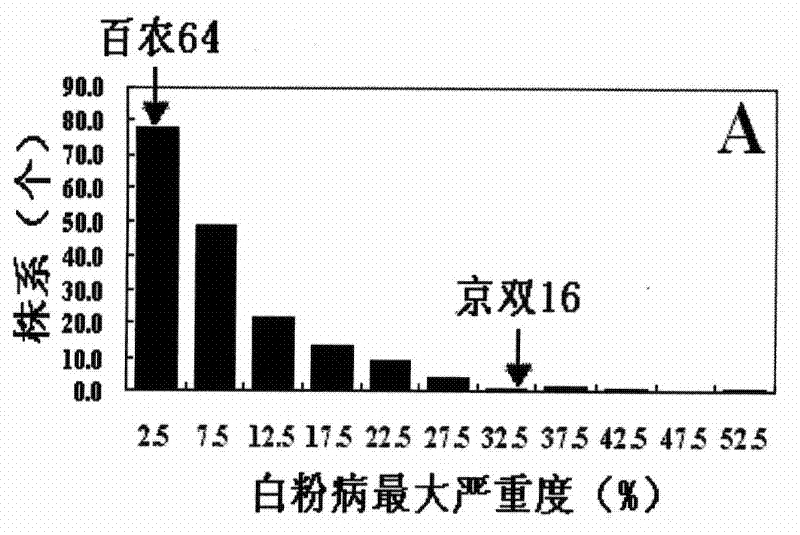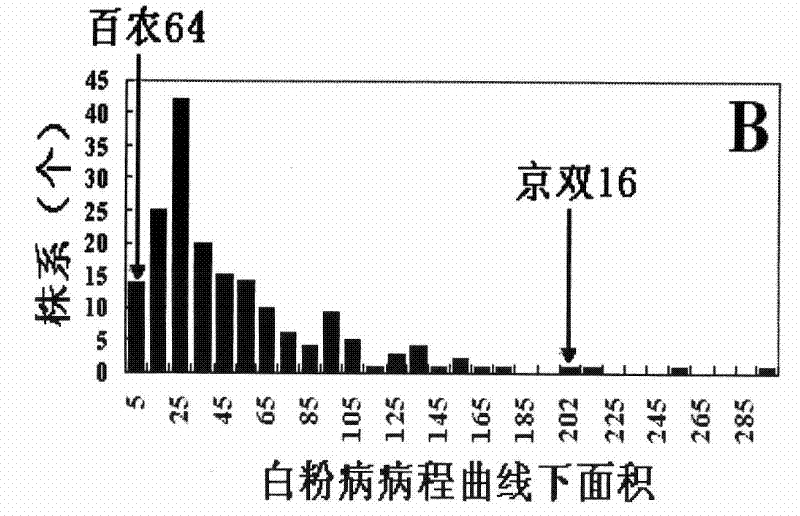A method for auxiliary screening of powdery mildew resistant wheat and its special primers
A technology for resistance to powdery mildew and wheat, which is applied in the fields of botanical equipment and methods, biochemical equipment and methods, and applications, and can solve problems such as hidden dangers in production, strong reproductive ability, and loss of resistance of major disease resistance genes.
- Summary
- Abstract
- Description
- Claims
- Application Information
AI Technical Summary
Problems solved by technology
Method used
Image
Examples
Embodiment 1
[0025] Example 1. Molecular markers Xbarc79 and Xwmc288 of powdery mildew resistance gene and acquisition of special primers thereof
[0026] The production of haploid wheat plants from wheat×maize crosses. Theor. Appl. Genet. 76: 393-397 was obtained by using Bainong 64 and Jingshuang 16 through the wheat×maize cross method (Laurie and Bennett, 1988, The production of haploid wheat plants from wheat×maize crosses. Theor.Appl. Genet. 76: 393-397) DH groups.
[0027] 1. Acquisition of phenotypes and their performance in the field
[0028]The powdery mildew race E20 (Duan et al. 1993, Establishment of wheat powdery mildew isolates with putative virulence genotype. Plant Prot. 19: 27-28), which is currently popular in wheat in my country, was used to test Bainong 64×Jingshuang 16DH containing 181 families. The populations were identified for adult plant resistance in 2005-06 and 2007-08 in Beijing and Anyang, respectively. The results showed that the maximum disease severity (MD...
Embodiment 2
[0043] Example 2, application of molecular markers Xbarc79 and Xwmc288 and their special primers
[0044] 1. Detect whether different strains and varieties of wheat carry molecular markers Xbarc79 and / or Xwmc288
[0045] Using the DH population line produced by the hybrid offspring of Bainong 64 and Jingshuang 16 and the genomic DNA of the wheat variety to be tested as templates, the primer pair Xbarc79-1 and Xwmc288-1 were used for PCR amplification.
[0046] The 15 μl PCR reaction system consists of: 20ng template DNA, 450 μM dNTPs (purchased from Tiangen Company), 0.95U Taq DNA polymerase (purchased from Tiangen Company), 1.5 μl 10×PCR buffer (purchased from Tiangen Company) Company), 4pmol primer pair Xbarc79-12.3μl, 4pmol primer pair Xwmc288-12.3μl, supplement the reaction system with sterile distilled water to 15μl. The procedure of PCR amplification was as follows: pre-denaturation at 94°C for 5 minutes; then denaturation at 94°C for 1 minute, annealing at 52°C for 1 m...
PUM
 Login to View More
Login to View More Abstract
Description
Claims
Application Information
 Login to View More
Login to View More - R&D
- Intellectual Property
- Life Sciences
- Materials
- Tech Scout
- Unparalleled Data Quality
- Higher Quality Content
- 60% Fewer Hallucinations
Browse by: Latest US Patents, China's latest patents, Technical Efficacy Thesaurus, Application Domain, Technology Topic, Popular Technical Reports.
© 2025 PatSnap. All rights reserved.Legal|Privacy policy|Modern Slavery Act Transparency Statement|Sitemap|About US| Contact US: help@patsnap.com



